Mexico, a land of vibrant colours and deep-rooted traditions, invites travellers to a world where ancient civilisations, lush landscapes, and bustling cities coexist. From the mysterious ruins left by the Mayans and Aztecs to the white sandy beaches of its extensive coastlines, Mexico offers an array of experiences for every kind of traveller.
As you journey through this article, you’ll discover a selection of the most iconic sights that should top any visitor’s itinerary. Each destination tells a unique story, weaving together the threads of history, culture, and natural beauty into a rich tapestry that defines Mexico.
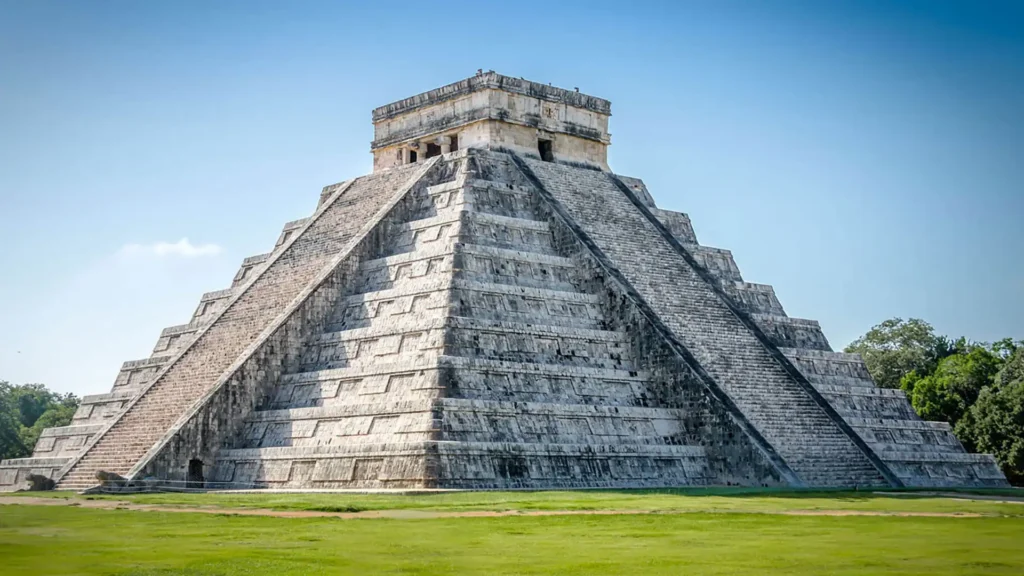
The ancient city of Chichén Itzá stands as a monumental testament to the ingenuity and artistry of the Mayan civilization. Once a major focal point in the Mayan world, this site, located on the Yucatan Peninsula, showcases a blend of architectural styles reflective of diverse influences over time.
The centrepiece is El Castillo, also known as the Temple of Kukulcan, a pyramid that dominates the landscape. This structure is not just an architectural marvel but also an astronomical wonder.
During the equinoxes, the play of light and shadow creates the illusion of a serpent ascending or descending the steps, a sight that draws thousands of visitors annually.
Wandering through Chichén Itzá, one can’t help but feel a connection to the past. The Ball Court, the largest of its kind in the Americas, echoes with the ancient games that were played here, often with high stakes.
The intricate carvings on the stone walls depict scenes from these games and offer insight into the religious and social practices of the Mayans. Nearby, the sacred Cenote, a natural sinkhole, was a place of pilgrimage and sacrifice, further emphasizing the spiritual significance of this site.
As you explore, the sound of local guides and the chatter of awe-struck tourists fill the air, yet there’s a palpable sense of mystique that hangs over the ruins. The history of Chichén Itzá is a complex tapestry of cultural evolution, innovation, and mythology.
To fully appreciate its grandeur, one must not only admire its physical beauty but also understand the historical and cultural context that makes it a jewel in the crown of Mexico’s archaeological sites.
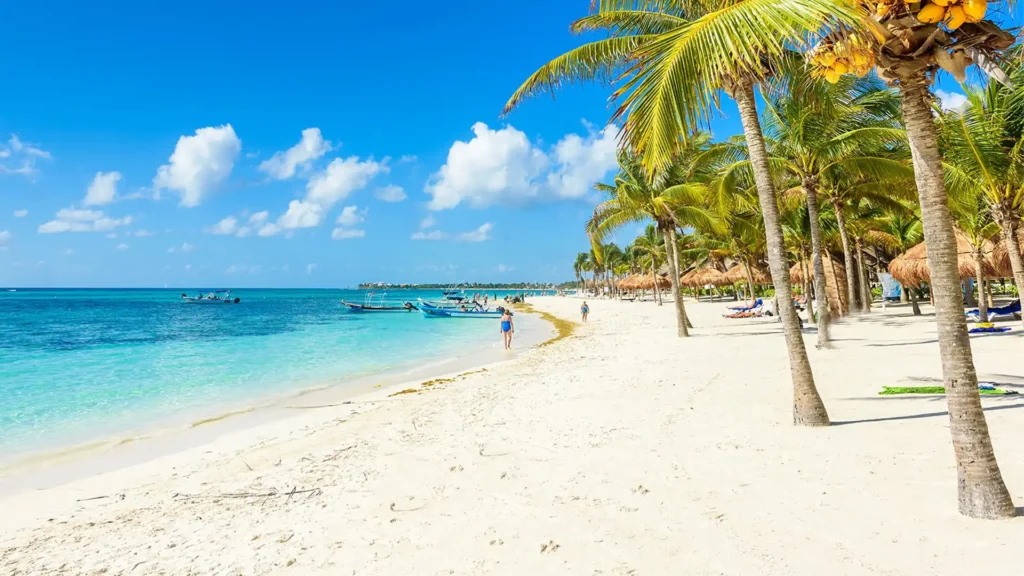
Cancún, a name synonymous with crystal-clear waters and pristine white sands, offers a beach experience that rivals any tropical paradise. Situated on the Yucatan Peninsula, this destination is famed for its vibrant nightlife, luxurious resorts, and, most importantly, its breathtaking beaches.
The most famous among them is Playa Delfines, a quintessential postcard scene with turquoise waters and powdery sands. It’s a place where visitors can lounge under the sun, swim in the warm Caribbean waters, or simply enjoy the serene beauty.
But Cancún’s beaches are more than just places to relax and sunbathe. For the adventurous, the waters here are a playground. Activities like snorkelling, scuba diving, and jet skiing are readily available, providing thrilling ways to explore the rich marine life.
The Mesoamerican Barrier Reef, just a short distance away, is a snorkeler’s dream, teeming with colourful fish and intricate coral formations. In contrast, the Underwater Museum of Art offers a unique underwater experience where art and conservation efforts merge.
Beyond the water activities, the beaches of Cancún are lined with a variety of dining and entertainment options. From quaint beachside cafes serving fresh seafood to upscale restaurants with gourmet international cuisine, there’s something to satisfy every palate.
As the sun sets, the beach transforms, with the sound of waves providing a soothing backdrop to the vibrant nightlife. The beachfront clubs and bars come alive, offering a glimpse into the spirited side of Mexican culture. Whether seeking relaxation, adventure, or a bit of both, Cancún’s beaches are a microcosm of the diverse experiences that Mexico has to offer.
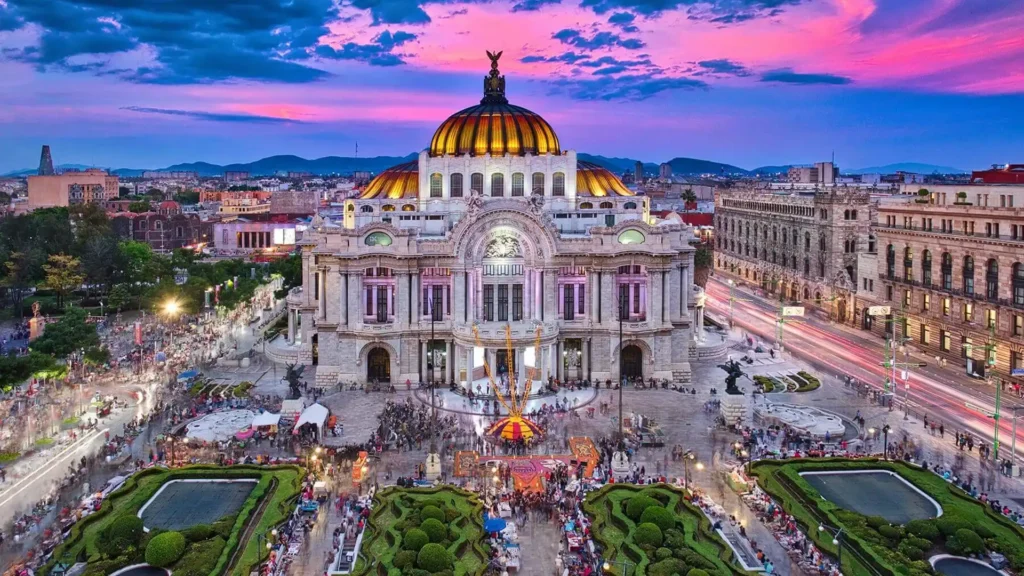
Stepping into the Historic Centre of Mexico City, also known as Centro Histórico, is like walking through the pages of a history book. This bustling heart of the capital is home to an array of architectural masterpieces, each telling a story of the city’s rich and tumultuous past.
The Zócalo, the main square, is one of the largest city squares in the world and has been the centre of public life since Aztec times. Surrounded by historic buildings, it hosts a variety of events, from cultural celebrations to political gatherings.
One of the most notable landmarks in the Historic Centre is the Palacio Nacional, a magnificent building that houses stunning murals by Diego Rivera.
These murals are not just art; they are vibrant narratives that depict the history of Mexico, from the pre-Columbian period to the post-revolutionary era. A visit here offers a profound insight into the country’s past and present, encapsulating the struggles and triumphs of the Mexican people.
Wandering through the streets of the Historic Centre, one can’t help but be captivated by the blend of colonial and modern architecture. The Metropolitan Cathedral, with its intricate façades and grand interior, stands as a symbol of the city’s colonial history.
Nearby, the Templo Mayor, an Aztec archaeological site, offers a glimpse into the pre-Hispanic era of Mexico City. This juxtaposition of the ancient and the colonial exemplifies the layered history that defines not only the city but the entire country.
The Historic Centre is not just a place of monuments and museums; it’s a living, breathing part of Mexico City with markets, restaurants, and street performers adding to its vibrant atmosphere.
From traditional dishes being served in bustling markets like La Merced to the sound of mariachi bands filling the air, the Centro Histórico is a sensory journey that immerses visitors in the essence of Mexican culture.
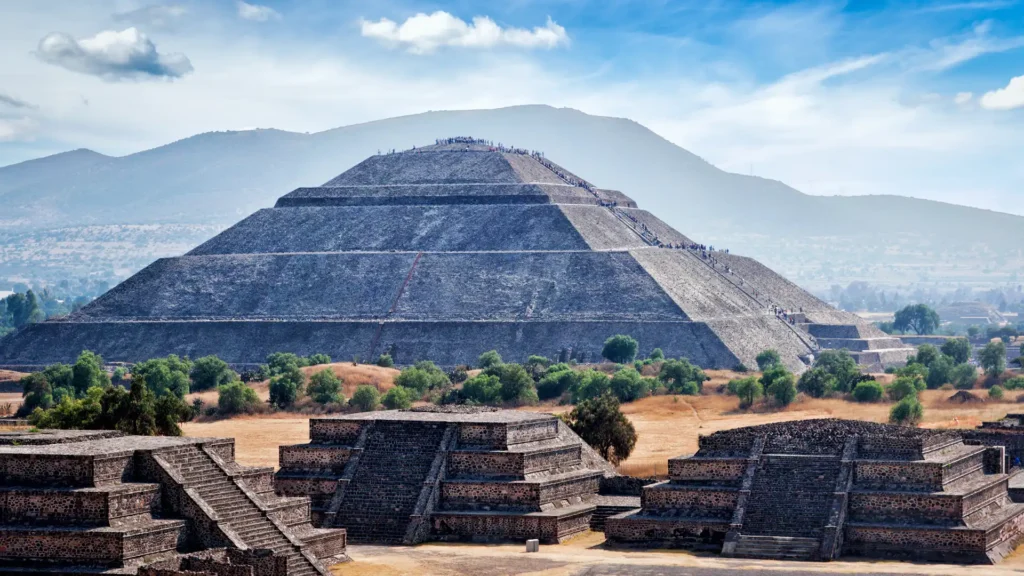
The ancient city of Teotihuacan, located just outside of Mexico City, is an archaeological marvel that speaks volumes of the mysterious civilization that once thrived here. The site, dominated by two massive pyramids – the Pyramid of the Sun and the Pyramid of the Moon – offers a glimpse into the grandeur of a lost world.
The Pyramid of the Sun, one of the largest structures of its kind in the Western Hemisphere, provides a breathtaking view for those who climb its 248 steps. From atop, visitors are treated to a panoramic vista of the entire complex and the surrounding valleys, a sight that is both awe-inspiring and humbling.
As you walk down the Avenue of the Dead, the main thoroughfare of Teotihuacan, the sense of scale and sophistication of this ancient city becomes apparent. Along the avenue, numerous smaller structures, once temples and palaces, line the path, each with its own story to tell.
The Pyramid of the Moon, though smaller than its counterpart, offers a unique view of the ceremonial axis of Teotihuacan, aligning with the setting of the sun during certain times of the year, revealing the astronomical knowledge of its builders.
Visiting Teotihuacan is not just about admiring its monumental architecture; it’s about connecting with the past. The murals that adorn some of the buildings, though faded with time, show vivid depictions of everyday life, religious rituals, and mythical scenes, providing insight into the beliefs and customs of its inhabitants.
The site’s museum adds another layer to this experience, with artifacts and models that bring the city and its people to life.
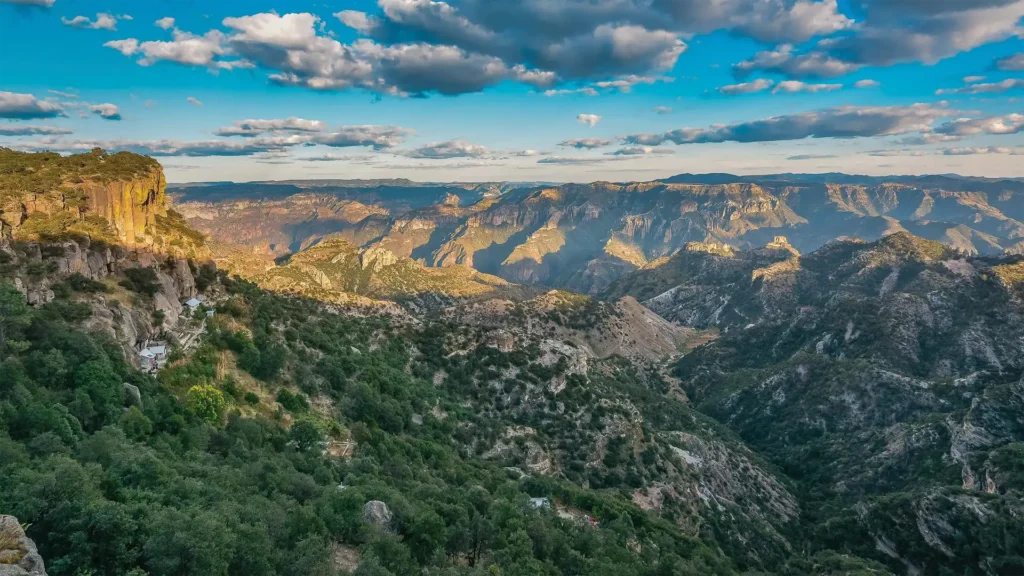
Copper Canyon, a network of six distinct canyons in the Sierra Madre Occidental in the state of Chihuahua, is a natural wonder that rivals the Grand Canyon in its beauty and scale. Known locally as Barranca del Cobre, the area is renowned for its breathtaking landscapes, diverse wildlife, and the rich culture of the indigenous Rarámuri people.
The canyons, each unique in its geological formations, are a paradise for nature enthusiasts and adventure seekers alike. Hiking, horseback riding, and zip-lining are just a few ways to explore the rugged terrain.
The heart of Copper Canyon is best explored through the famous Chihuahua al Pacifico Railway, affectionately known as El Chepe. This train journey, considered one of the most scenic in the world, winds through towering cliffs, bridges, and tunnels, offering passengers an unparalleled view of the canyon’s vastness and beauty.
The journey stops at various points, allowing visitors to experience local culture, cuisine, and the natural wonders of the region, including the majestic Basaseachi Falls and the serene Lake Arareko.
The Rarámuri, or Tarahumara, people, who have called these canyons home for centuries, add a rich cultural dimension to the region. Their villages, perched on canyon rims or nestled in the valleys, offer a window into a way of life that has remained largely unchanged over time.
Their colourful clothing, traditional crafts, and endurance running abilities are just a few aspects that intrigue visitors. The annual Ultra Marathon Caballo Blanco, which brings together Rarámuri and international runners, is a testament to the spirit of cooperation and respect between the locals and the outside world.
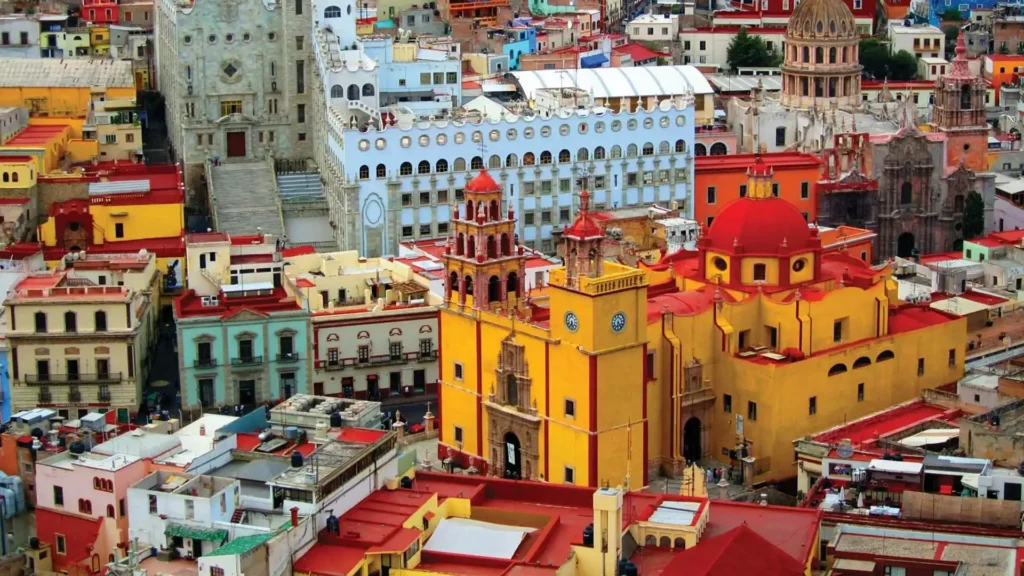
Guanajuato, a UNESCO World Heritage site nestled in the mountains of central Mexico, is a city that charms visitors with its colourful architecture, winding streets, and rich history. Known for its significant role in Mexico’s independence movement, the city is a living museum of Mexican history and culture.
The streets of Guanajuato, with their vibrant colours and baroque and neoclassical buildings, are a feast for the eyes. The city’s unique network of underground tunnels, originally built to prevent flooding, now serves as streets and is a distinctive feature that adds to its allure.
A focal point of the city is the Teatro Juárez, a splendid theatre that showcases a mix of Moorish, Romanesque, and Baroque architectural styles. The theatre’s opulent interior, with its lavish decor and grand stage, hosts a variety of performances, making it a cultural hub in the city.
Another must-visit is the Alhóndiga de Granaditas, a historic building turned museum that played a pivotal role during the early stages of the Mexican War of Independence.
Guanajuato’s lively atmosphere is further enriched by its numerous festivals. The Festival Internacional Cervantino, one of the largest and most prestigious cultural festivals in Latin America, transforms the city into a global stage for music, art, theatre, and dance.
The streets come alive with performances and exhibitions, drawing artists and audiences from around the world. Beyond the festivals, the city’s many plazas and markets offer a taste of local life, with food stalls serving traditional dishes, artisans selling handcrafted goods, and musicians filling the air with the sounds of mariachi and folk music.
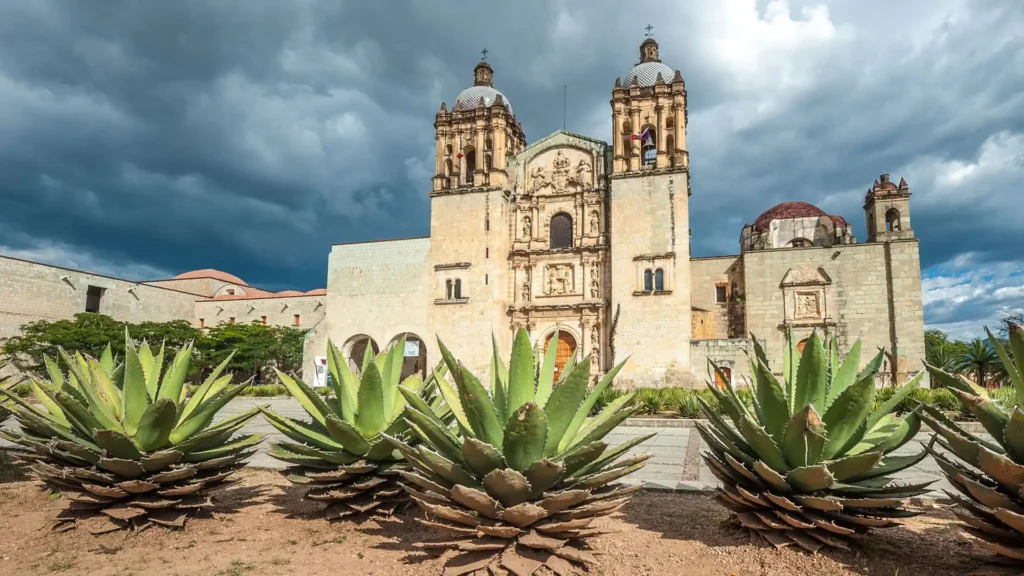
Oaxaca, a region renowned for its cultural richness and diversity, offers a tapestry of experiences that embody the essence of Mexican heritage. This area is celebrated for its indigenous cultures, particularly the Zapotec and Mixtec communities, whose influence is evident in the region’s traditions, art, and architecture.
The city of Oaxaca, with its colonial buildings and cobbled streets, is a hub of activity where ancient customs blend seamlessly with modern life. The Zócalo, Oaxaca’s main square, is a lively gathering place where locals and visitors alike come to enjoy the festive atmosphere, accompanied by street performers and vendors.
One of the most striking aspects of Oaxaca is its vibrant arts scene. The region is famous for its unique folk art, including the brightly coloured alebrijes, handcrafted textiles, and intricately painted ceramics.
These crafts are not just tourist souvenirs but are deeply rooted in the local culture, each piece telling a story and reflecting the rich artistic heritage of the region.
Workshops and galleries throughout the city offer a chance to see artisans at work and to learn about the processes and traditions behind their creations.
The culinary offerings in Oaxaca are as diverse and rich as its culture. Known as the land of seven moles, the region’s cuisine is a highlight for food enthusiasts.
Dishes like mole negro, tlayudas, and chapulines showcase the depth and complexity of Oaxacan flavours. Local markets, such as the bustling Mercado Benito Juárez, provide an immersive experience into the region’s culinary landscape, with stalls overflowing with fresh produce, spices, and Oaxacan cheeses.
The mezcal, a smoky spirit distilled from agave, is another must-try, with local distilleries offering tastings and insights into the traditional production methods.
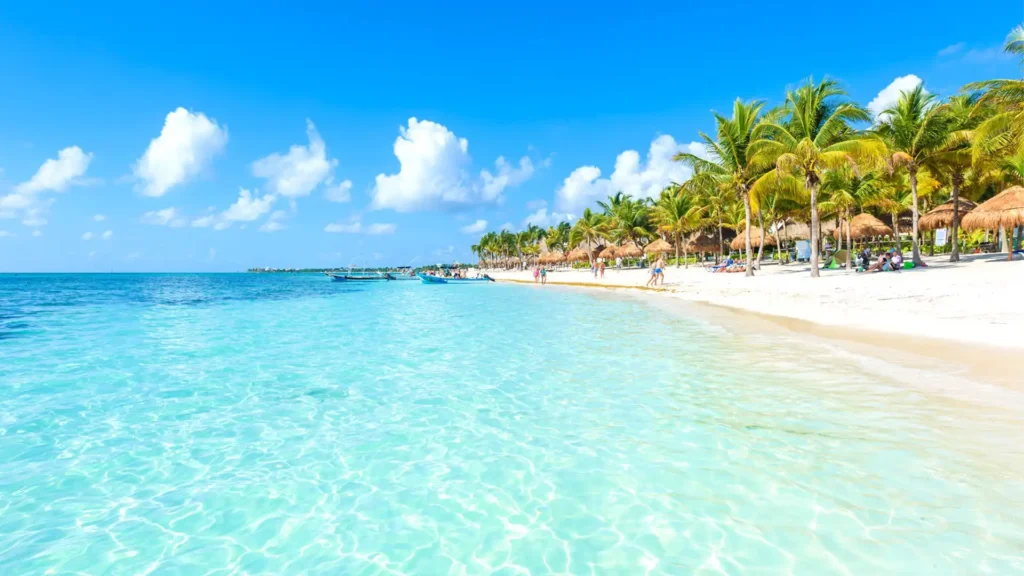
The Mayan Riviera, stretching along the Caribbean coastline of the Yucatan Peninsula, is a world of contrasts, where ancient ruins meet modern luxury, and lush jungle meets crystal-clear waters.
This region, which includes popular destinations like Playa del Carmen, Tulum, and Cozumel, is a paradise for beach lovers, history enthusiasts, and eco-adventure seekers.
The white sandy beaches and turquoise waters are a hallmark of the Riviera, offering idyllic settings for relaxation and water sports. Places like Akumal Beach provide opportunities for snorkelling with sea turtles, while the beaches of Tulum offer a unique backdrop with ancient Mayan ruins.
Beyond the beaches, the Mayan Riviera is steeped in history. Tulum, standing atop a cliff overlooking the Caribbean Sea, is one of the last cities built and inhabited by the Maya. Its well-preserved ruins, particularly the iconic El Castillo, are a testament to the architectural prowess of the ancient civilization.
Similarly, the Coba ruins, nestled in the jungle, offer a more off-the-beaten-path experience with fewer crowds and the chance to climb one of the tallest Mayan pyramids.
For those seeking adventure, the region is dotted with cenotes – natural sinkholes filled with fresh water, formed by the collapse of limestone bedrock. These cenotes, once sacred to the Maya, are now popular spots for swimming, snorkelling, and diving.
The Rio Secreto, a subterranean river system with dramatic stalactites and stalagmites, provides an unforgettable experience of exploring underground caves. The Mayan Riviera, with its diverse attractions, truly offers something for everyone, blending natural beauty, historical richness, and modern amenities.
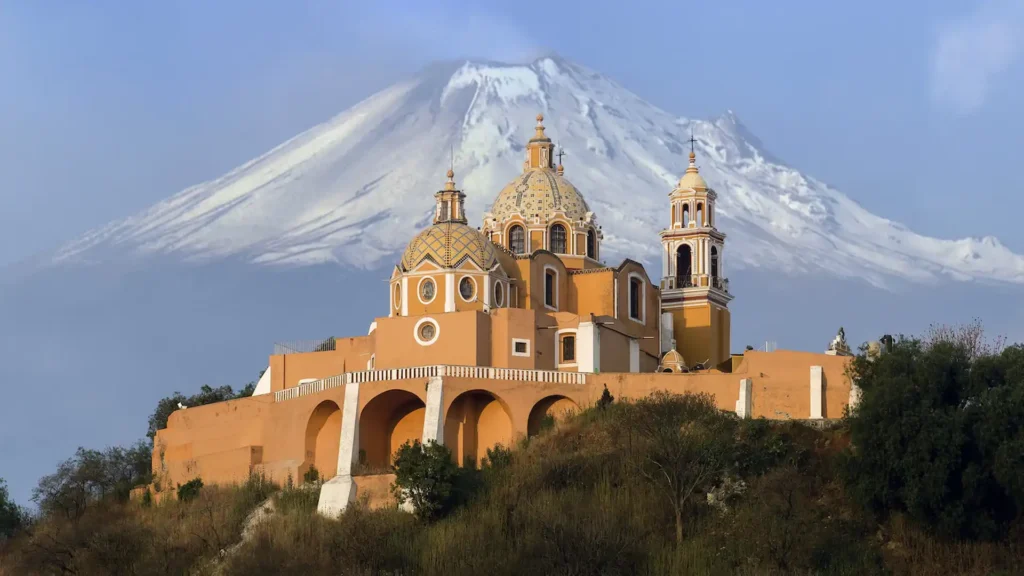
Puebla, a city framed by the Popocatépetl and Iztaccíhuatl volcanoes, is a jewel in Mexico’s colonial crown. This UNESCO World Heritage site is celebrated for its well-preserved architecture, vibrant street life, and, most notably, its distinctive culinary traditions.
The city’s historic centre is a maze of narrow streets lined with colourful buildings, ornate churches, and grand plazas. The Puebla Cathedral, with its impressive façade and towering bell towers, dominates the city’s skyline and is a magnificent example of Mexican Baroque architecture.
One of the most distinctive features of Puebla is its Talavera pottery. This hand-painted ceramic, characterized by its intricate designs and bright colours, is not only a beautiful craft but also an important part of Puebla’s cultural heritage.
Visitors can explore the Talavera workshops to witness the skilled artisans at work and learn about the traditional techniques that have been passed down through generations.
Puebla’s reputation as a culinary destination is largely due to its most famous dish, mole poblano. This complex sauce, made with a blend of spices, chocolate, and chili peppers, is a symbol of Mexico’s mestizo cuisine, combining indigenous and European influences.
The city’s gastronomic scene goes beyond mole, with dishes like chiles en nogada, cemitas, and tamales poblanos offering a taste of the region’s diverse flavours. Street food stands, local markets, and high-end restaurants all provide opportunities to indulge in Puebla’s culinary delights, making it a must-visit destination for food lovers.
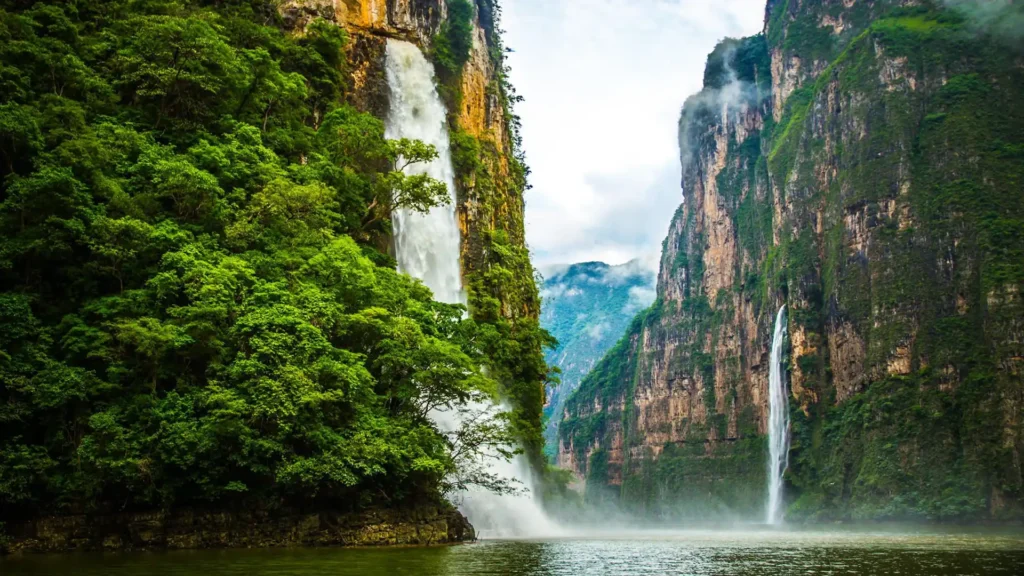
Sumidero Canyon, located in the southern state of Chiapas, is a magnificent natural wonder that offers a dramatic landscape of towering cliffs, lush vegetation, and abundant wildlife.
This canyon, created by the Grijalva River cutting through the Sierra Norte de Chiapas, reaches depths of over a kilometre in some places, making it one of the most impressive geological formations in Mexico. The best way to experience the majesty of Sumidero Canyon is by taking a boat tour along the Grijalva River.
These tours provide a close-up view of the towering rock walls, some of which rise vertically for over a thousand meters, and the opportunity to see the diverse flora and fauna, including crocodiles, monkeys, and a variety of bird species.
Apart from the boat tours, several lookout points along the canyon’s rim offer breathtaking views of the landscape. These viewpoints, accessible by road, provide a different perspective of the canyon’s grandeur. Places like La Ceiba and La Coyota overlooks not only present stunning vistas but also serve as excellent spots for photography enthusiasts.
The sight of the river winding through the massive canyon, with the lush greenery of the Chiapas highlands in the background, is a scene of unparalleled natural beauty.
Sumidero Canyon is not just a natural spectacle; it also holds cultural significance. The canyon has been a crucial part of the local ecosystem and has played a role in the history and culture of the indigenous peoples of Chiapas.
The area surrounding the canyon is rich in biodiversity, with several protected areas and national parks, making it an important region for conservation efforts.
Additionally, Chiapa de Corzo, the charming town near the entrance of the canyon, adds a cultural dimension to the visit. This town, known for its colonial architecture and vibrant festivals, is an ideal place to experience the local culture and cuisine.